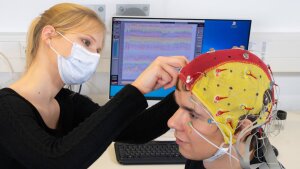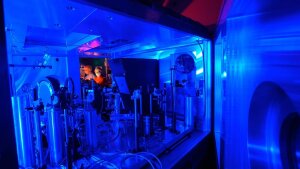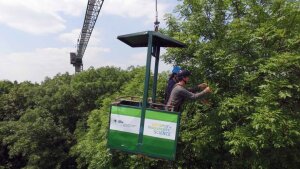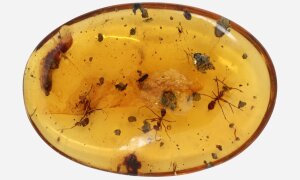Ticker
Recognizing emotions with implants
PhD student Celina von Eiff attaches electrodes to a subject's cap for the EEG study with cochlear implants.
Image: Jens Meyer (University of Jena)Cochlear implants can help people with hearing loss to perceive acoustic stimuli. Unlike hearing aids, which usually only amplify sounds, electronic prostheses actually stimulate the cochlear nerve. A team of researchers led by Celina von Eiff at the Institute of Psychology have been investigating whether the implants also allow their users to pick up nuances, i.e., how something is said. The researchers have conducted an extensive study and found that the perception of vocal emotions is significantly reduced in cochlear implant wearers. The results of their study have been published in the scientific journal »Ear and Hearing« (DOI: 10.1097/AUD.0000000000001181External link). [sh]
High-energy proton beams
Experiment to accelerate protons with laser pulses from the POLARIS system.
Image: Jens Meyer (University of Jena)When proton beam therapy is used to treat tumors, large acceleration systems are still required. A team of researchers led by Prof. Dr Malte Kaluza are currently working on how proton beams can be generated with smaller laser systems using laser-plasma interactions and have analysed various parameters that play a role in this. Based on their results, which have been published in the journal »Physical Review Research« (DOI: 10.1103/PhysRevResearch.4.013065External link), they have devised a set of optimal conditions that maximize the energy yield of a proton beam. This will enable future laser systems to be configured in such a way that proton beams can be generated with a significantly higher energy yield than before. [US]
Green hydrogen on demand
Irradiation apparatus with which measurements were carried out for the current publication.
Image: Heiko GrandelScientists from the »CataLight« Transregional Collaborative Research Centre have presented a solution approach to one of the greatest challenges of solar energy conversion. The team of researchers, including Prof. Dr Benjamin Dietzek-Ivanšić and Prof. Dr Ulrich Schubert from the University of Jena, has managed to develop a system that enables the light-driven production of hydrogen at any time of the day or year. Future areas of application for this photochemical unit range from needs-based heat generation to supplying hydrogen-powered vehicles »on demand«. The researchers from the universities of Ulm and Jena have presented their system, which is based on a single molecule that can absorb sunlight, store energy, and produce hydrogen, in the scientific journal »Nature Chemistry« (DOI: 10.1038/s41557-021-00850-8External link). [Bingmann/AB]
Chemical distress calls from trees
The »cry for help« was detected for the first time in the natural habitat – in the leaf canopy of the Leipzig Riverside Forest.
Image: iDivWhen forest trees are infested with caterpillars, they emit scents to attract predatory insects and birds and rid themselves of their pests. This phenomenon, which had previously only been detected in laboratory and garden experiments, has now been verified in a natural habitat – the 40-metre-high canopy of Leipzig Riverside Forest – by a team of researchers from the German Centre for Integrative Biodiversity Research Halle-Jena-Leipzig (iDiv) and the universities of Jena and Leipzig, led by Prof. Dr Nicole van Dam. The chemical distress calls are so effective that they have a major impact on the type of insects found in the canopy. In the future, this knowledge could be used for natural pest control in agriculture and forestry, as highlighted by the researchers in the journal »Ecology Letters« (DOI: 10.1111/ele.13943External link). [Tilch]
The phenomenon of terrorism
A person looks at pictures on her smartphone and laptop depicting activities of the so-called Islamic State.
Image: Jan-Peter Kasper (University of Jena)Historian Prof. Dr Carola Dietze from the University of Jena and her colleague Claudia Verhoeven from Cornell University have published »The Oxford Handbook of the History of Terrorism« (ISBN: 978-0199858569). In it, the researchers explore questions about terrorism and examine its social preconditions and consequences. According to the editors, terrorism today relies on mass media in order to have its effect – and the Internet is the ideal medium. Perpetrators can use the Internet themselves and provide the images that are important to them. The message of violence is always aimed at two target groups: a group of potential sympathizers and a group of people in whom they want to instil terror. [sl]
Renaissance of the concept of class
Warning strike of educational institutions 2011 at Ernst-Abbe-Platz Jena.
Image: Jan-Peter Kasper (University of Jena)A team of sociologists from the University of Jena have published a new book entitled »Die Wiederkehr der Klassen. Theorien, Analysen, Kontroversen« (The Return of Class. Theories, Analyses, Controversies , ISBN: 978-3-593-51359-1). They take up the theory proposed by Prof. Dr Klaus Dörre, who refers to a »demobilized class-based society«. Indeed, there is still a class of the wealthy opposite the class of the wage-dependent. But the wage-dependents today look different from the working class as described by Karl Marx, for example. In addition, new groups can be distinguished within the wage-dependent class: a successful class of »higher earners«, the traditional working class and a precariously employed lower class that fluctuates between jobs and state benefits. [sl]
Mushroom genus goes its own way
Nikolai Löhr, PhD student at the Pharmaceutical Microbiology Working Group and first author of the study, shows anthraquinone compounds in organic solvent in an experimental set-up.
Image: Jens Meyer (University of Jena)A team of researchers from the Institute of Pharmacy at the University of Jena, the Leibniz Institute of Natural Product Research and Infection Biology in Jena and the University of Freiburg have been studying the Cortinarius genus of mushrooms and discovered a previously unknown example of »convergent evolution«, the process by which different organisms evolve similar traits to adapt to their environment. They have found that the mushrooms produce certain natural substances (anthraquinones) that are also found in bacteria, plants, and moulds. However, the mushrooms in the Cortinarius genus have developed their very own metabolic pathway for this purpose.
The team led by mycologist Prof. Dr Dirk Hoffmeister have presented their results in the scientific journal »Angewandte Chemie International Edition« (DOI: 10.1002/anie.202116142External link). Cortinarius is one of the most diverse genera of mushrooms. There are about 2,000 species around the world. [US]
Division of labour in ants
Fossils of female ants and a pupa enclosed in Cretaceous amber.
Image: Shûhei YamamotoAn international research team led by biologists from the University of Jena has discovered the earliest evidence to date of cooperative behaviour in ants in fossils. The researchers analysed the body structures of the extinct Gerontoformica genus of ants encased in amber and found that the insects followed a social system based on the division of labour over 100 million years ago, i.e., in the early Cretaceous period or at the time of the dinosaurs. The researchers obtained information about the species and body shape from micro-computed tomography images of the fossils, including the first ant pupa ever found in Cretaceous amber. The researchers have published the results of their work in the journal »Zoological Journal of the Linnean Society« (DOI: 10.1093/zoolinnean/zlab097External link). [sh]







